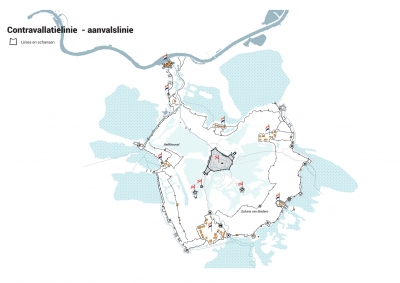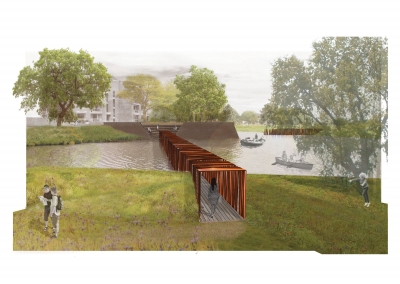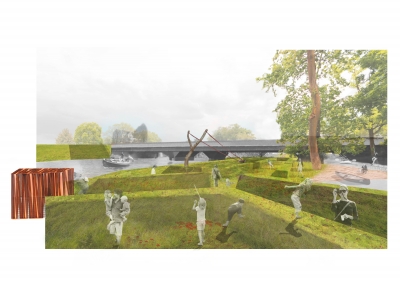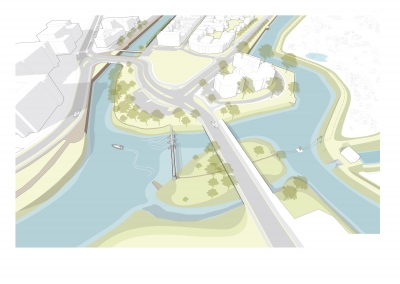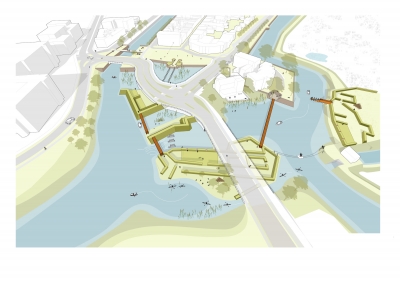
Park 1629
A junction of history, nature, recreation and trafficDuring the Eighty Years 'War, the State troops tried to, albeit failing five times, conquer the Catholic stronghold of' s-Hertogenbosch from the Spaniards. In 1628 Piet Hein conquered the Silver Fleet in the Bay of Matanzas. With this loot, Prince Frederick Henry of Orange, "the urban dwinger", who was also commander-in-chief of the State army, could give a new impulse to the war against the Spaniards. He decided to reinvest 's-Hertogenbosch with the deployment of 30,000 men, half of whom were foreign mercenaries. The city with the nickname "The Marsh Dragon" was difficult to capture due to the extensive fortifications and the marshy environment. First of all, a state-of-the-art circumvallation line of 45 kilometers was constructed by the State forces to close the city from the outside world. Inside, a 25-kilometer long counter-line line was constructed behind which the attacks on the city were prepared and the city was shot at with artillery. Together, the two lines counted 94 redoutes, 17 horns and 9 jumps. The swampy area between the fortifications of the city and the countervallation line was pumped empty with the help of horse mills. "Approaches" (approach or assault trenches) were then constructed from various directions with which the State Soldiers tried to approach the city. Frederik Hendrik's base camp was near Vught. From here, first Fort Isabella was captured and then Fort Sint Anthonie. Assault works were then dug along Vughterweg to get closer to the city's defenses. The preliminary work was achieved with the help of covered bridges of wood and earth (galleries). The bridge sections of the bridge between the front and the Vughterpoort had been removed by the Spanish troops. A part of the fortress wall of Bastion Vught was blown up through another gallery. The beating of this "breach" led to the surrender of the city and was world news at the time.
more...
This marked the turning point in the Eighty Years' War.
The final phase of the months-long siege of 's-Hertogenbosch took place on and around the current Wilhelminaplein. With the recent and greatly simplified traffic engineering redesign of the square, space has been created for making the missing part of the fortress wall and the Vughterpoort visible. Bringing back the defenses of the city, however, is only part of the story that can be brought to life here. Perhaps even more impressive were the assault works of the States with which they made their way in the direction of the city. It is precisely because of the historical importance of this attack that we also propose to make the attack works visible at this location, thereby creating a complete picture of the battle scene.
Our proposal is to take the situation at the time of the fall of the city in 1629 as the starting point for the reconstruction of both the defense works and the attack works. The current asphalt roads and the new course of the Dommel cut as it were through the situation of 1629. To reinforce this effect of stratification, the transition between 'old and new' is turned on as sharply as possible with vertical walls at a number of places with reflective lining (reference mirror wall Museumpark Rotterdam). As a result, the water sometimes even seems to run under the road. Especially from the Vughterpoort this gives a magical effect, whereby the traffic seems to float above the water.
Wherever possible, the fortress wall will be reduced. At Bastion Vught, the breach in the wall is made visible and takes shape as a sculptural brick amphitheater. The terrace of restaurant Noble offers a beautiful view of this historic feat. The contours of the Vughter gate are modestly indicated (also the role of this gate was modest in 1629) with corten steel and the piles of the bridge. The space behind the gate remains open (for events) and is reserved for a possible underground parking garage. From Bastion Deuteren on either side of the Dommel can be built a starter of the fortress wall. The earthen crescent moon (later ravelein) and the extra preliminary work raised by the defenders in a hurry are also being reduced. This also creates new ecological stepping stones for amphibious nature. The weir will be maintained. The west side of the Dommel is also furnished with nature-friendly banks. On the already existing island south of the weir, the earthen embankments that were part of the attack works are being reconstructed. This creates a beautiful "pocket park" that is divided into different spaces by the ramparts. These different spaces can also be programmed differently, for example as a botanical garden, an adventure garden for children, etc. The artillery once erected here is depicted in an abstract way. On the south side there is a city beach with a view of the moved canoe bridge. The park can be further expanded via the existing foot ferry by also reducing the earthen attack works in the Bossche Broek.
The most striking are the four sculptural corten steel pedestrian bridges at the locations of the galleries of the Staatsen. Together they combine the attack and defense works into a recreational route and a major cultural and historical destination. Visitors can conquer Den Bosch again and again via the longest gallery, which ends at the breach. The gallery between the Bossche Broek and Bastion Vught has never reached the other side and could now, like a pont d’Avignon, symbolize a place of desire (pont d’ámour). The (historically correct) spatial composition of the four galleries, on either side of the Vughterweg and clearly visible to the passing traffic, is beautiful and together these galleries form the new gateway to Den Bosch.
In addition to being a pivotal point in history, the location is also an important ecological and recreational hub via land and water. Bringing back the defenses creates at the same time many new conditions, on the transition of land and water, for amphibious nature and biodiversity. It also offers countless new reasons for recreational use. That is the essence of Park 1629; a node of history, nature, recreation and traffic.
The final phase of the months-long siege of 's-Hertogenbosch took place on and around the current Wilhelminaplein. With the recent and greatly simplified traffic engineering redesign of the square, space has been created for making the missing part of the fortress wall and the Vughterpoort visible. Bringing back the defenses of the city, however, is only part of the story that can be brought to life here. Perhaps even more impressive were the assault works of the States with which they made their way in the direction of the city. It is precisely because of the historical importance of this attack that we also propose to make the attack works visible at this location, thereby creating a complete picture of the battle scene.
Our proposal is to take the situation at the time of the fall of the city in 1629 as the starting point for the reconstruction of both the defense works and the attack works. The current asphalt roads and the new course of the Dommel cut as it were through the situation of 1629. To reinforce this effect of stratification, the transition between 'old and new' is turned on as sharply as possible with vertical walls at a number of places with reflective lining (reference mirror wall Museumpark Rotterdam). As a result, the water sometimes even seems to run under the road. Especially from the Vughterpoort this gives a magical effect, whereby the traffic seems to float above the water.
Wherever possible, the fortress wall will be reduced. At Bastion Vught, the breach in the wall is made visible and takes shape as a sculptural brick amphitheater. The terrace of restaurant Noble offers a beautiful view of this historic feat. The contours of the Vughter gate are modestly indicated (also the role of this gate was modest in 1629) with corten steel and the piles of the bridge. The space behind the gate remains open (for events) and is reserved for a possible underground parking garage. From Bastion Deuteren on either side of the Dommel can be built a starter of the fortress wall. The earthen crescent moon (later ravelein) and the extra preliminary work raised by the defenders in a hurry are also being reduced. This also creates new ecological stepping stones for amphibious nature. The weir will be maintained. The west side of the Dommel is also furnished with nature-friendly banks. On the already existing island south of the weir, the earthen embankments that were part of the attack works are being reconstructed. This creates a beautiful "pocket park" that is divided into different spaces by the ramparts. These different spaces can also be programmed differently, for example as a botanical garden, an adventure garden for children, etc. The artillery once erected here is depicted in an abstract way. On the south side there is a city beach with a view of the moved canoe bridge. The park can be further expanded via the existing foot ferry by also reducing the earthen attack works in the Bossche Broek.
The most striking are the four sculptural corten steel pedestrian bridges at the locations of the galleries of the Staatsen. Together they combine the attack and defense works into a recreational route and a major cultural and historical destination. Visitors can conquer Den Bosch again and again via the longest gallery, which ends at the breach. The gallery between the Bossche Broek and Bastion Vught has never reached the other side and could now, like a pont d’Avignon, symbolize a place of desire (pont d’ámour). The (historically correct) spatial composition of the four galleries, on either side of the Vughterweg and clearly visible to the passing traffic, is beautiful and together these galleries form the new gateway to Den Bosch.
In addition to being a pivotal point in history, the location is also an important ecological and recreational hub via land and water. Bringing back the defenses creates at the same time many new conditions, on the transition of land and water, for amphibious nature and biodiversity. It also offers countless new reasons for recreational use. That is the essence of Park 1629; a node of history, nature, recreation and traffic.
year
2016
team
ir. Marco Vermeulen, ir. Wout Kruijer, ir. Bram Willemse
programme
Research vision
client
Gemeente 's-Hertogenbosch
website
www.s-hertogenbosch.nl
2016
team
ir. Marco Vermeulen, ir. Wout Kruijer, ir. Bram Willemse
programme
Research vision
client
Gemeente 's-Hertogenbosch
website
www.s-hertogenbosch.nl
next project:
Logistics Park Moerdijk
related projects



